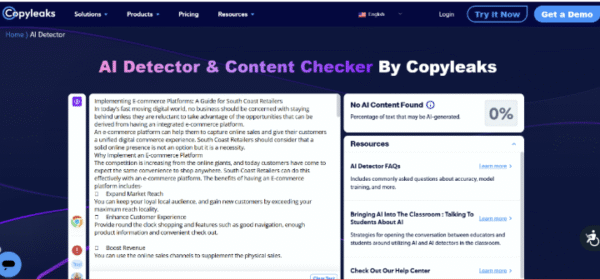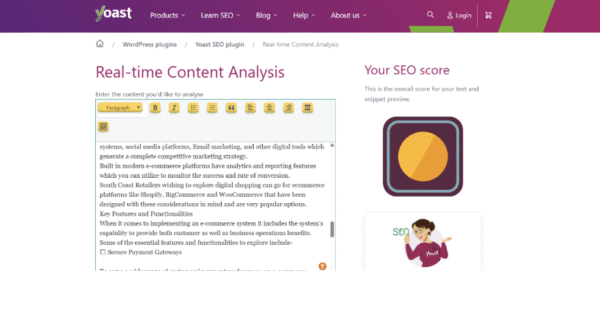In today’s fast-moving digital world, no business should be concerned with staying behind unless they are reluctant to take advantage of the opportunities that can be derived from having an integrated e-commerce platform. An e-commerce platform can help them capture online sales and give their customers a unified digital commerce experience. South Coast Retailers should consider that a solid online presence is not an option but it is a necessity.
Why Implement an E-commerce Platform
The competition is increasing from online giants, and today, customers have come to expect the same convenience to shop anywhere. South Coast Retailers can do this effectively with an e-commerce platform. The benefits of having an E-commerce platform include-
-
Expand Market Reach
You can keep your loyal local audience and gain new customers by exceeding your maximum reach locality.
-
Enhance Customer Experience
Provide round-the-clock shopping and features such as good navigation, enough product information, and convenient checkout.
-
Boost Revenue
You can utilize the online sales channels as a supplement to physical sales.
-
Stay Competitive
You can join the digital revolution and compete with local as well as national retailers. An integrated digital commerce strategy helps you to remain in the limelight both in the physical as well as in online marketplaces.
Planning Your Digital Transformation
Planning is the key before you intend to go for digital transformation. You need to first determine a holistic evaluation of the goals of your business and the needs of your customers. You need certain steps to be taken for planning your digital transformation, and these steps include-
-
Assess Current Resources
Assess your current as well as physical infrastructure. Think about whether your current website is up to date and scalable at the moment, if you do have one. Find out the technology gaps that need to be closed using a new e-commerce platform.
-
Define Your Goals
Does your goal in the next year to increasing your online sales by 25%? Are you interested in speeding up the information on your product and the checkout process? These types of clear targets will help you determine which platform to choose and how to implement your strategy.
-
Understand Your Audience
Study your customer’s demographics, shopping patterns, and preferences. You need to study the South Coast Retailers’ market insight which is key to knowing your e-commerce solution has a place for the needs of the South Coast Retailers’ clientele. According to recent stats, 81% of online shoppers conduct research before a purchase.
Transitioning to mobile first design and voice search optimization is important, since this is the time when many would be shopping on smart devices.
-
Budgeting and Resource Allocation
Evaluate yourself in terms of upfront costs (the costs that serve to realize the product, including design, development and integration) and ongoing expenses (expenses related to hosting, marketing and support). A well-planned budget is to avoid costs not expected during and after implementation.
Selecting the Right E-commerce Platform
The first and most essential step is to choose the right e-commerce platform. By following the processes, you can find a solution that matches your business’s technical, functional, and financial needs. These processes include-
-
Scalability and Flexibility
Pick a platform that will work with your future business. See if there are features for adding new products, multiple payment gateways and the option to customize.
-
User-Friendly Interface
Both your customers and in in-house team that will be managing the site should find the platform intuitive. It puts a minimal strain on training time, and this minimizes daily operations.
-
Mobile Optimization
The chosen e-commerce platform should be fully mobile-optimized. As the mobile shopper market continues to grow, it is critical to have fast-loading pages, a responsive design and ease of use on smartphones.
-
SEO Capabilities
The ecommerce platform should be built keeping SEO in mind. It should provide the options for customizable URLs, meta descriptions, title tags, image alt text, structured data, and all of these things are necessary to rank in search engines in 2025.
The performance and site speed are increasingly important to search engines, and sites that are well-performing on Core Web Vitals’ metrics will rank higher.
-
Integration with Marketing Tools
The e-commerce platform should have the ability to integrate with CRM systems, social media platforms, Email marketing, and other digital tools, which generate a complete competitive marketing strategy.
Built-in modern e-commerce platforms have analytics and reporting features that you can utilize to monitor the success and rate of conversion.
South Coast Retailers wishing to explore digital shopping can go for e-commerce platforms like Shopify, BigCommerce, and WooCommerce, which have been designed with these considerations in mind and are very popular options.
Key Features and Functionalities
When it comes to implementing an e-commerce system, it includes the system’s capability to provide both customer as well as business operations benefits. The basic features and functionalities to look at include-
-
Secure Payment Gateways
To serve a wide range of customers’ payment preferences, an e-commerce platform should be able to support a variety of payment methods such as credit cards, digital wallets, and emerging payment methods.
Most of the e-commerce platforms protect the sensitive data of the customers through security protocols like SSL encryption and PCI compliance.
-
Inventory Management
Inventory management systems help get rid of all your problems when it comes to ensuring products on your e-store match those in your physical stores. Inventory synchronization between online and offline inventories ensures they both contain the same stock and therefore no customer will be frustrated due to inconsistent stock.
-
Order Management and Fulfillment
Order management system with least impact on the customer experience is the need of the hour. The order management and fulfilment features automate shipping updates, order tracking, and even easy return process for the customer.
-
Analytics and Reporting
Data-driven decision-making is crucial. Tools like Google Analytics and Search Console should be incorporated into your platform to keep an eye on the Traffic, User behavior and Conversion rates. In essence, these insights help you know which products are worth providing to your customers and which areas need to be improved upon.
-
Customer Support Tools
You can add easy-to-access live chats, chatbots, and FAQs as your customer support tools. Customer support is a part of the customer experience and is essential to building trust.
-
Personalization and Recommendations
You can extract current user behavior and preferences to not only make shopping more personalized, but also to create solutions based on the shopping experiences of the customers.
Steps to Implement Your E-commerce Platform
An e-commerce platform essentially requires an implementation. You need to follow the following steps to implement your e-commerce platform as mentioned below
-
Project Kick-off
Begin by gathering a cross-functional team of IT, marketing, sales and customer support. Explain the project goals, timeline, and deliverables and stress that they are products to communicate to customers.
-
Platform Selection and Customization
Select the platform that best suits your business needs. Customize the platform’s getup and feel as per your brand with the help of experienced developers and designers. Make sure to have the design responsive, mobile-friendly and comply with 2025 SEO standards.
-
Data Migration
In case you are making the transition from one platform to another, make sure that the product information, customer, and historical transaction data are seamlessly merged into the new platform.
-
Integration Testing
Do a thorough test of the platform with all tools that integrate with it already such as payment gateways, CRM, shipping solutions, and marketing tools. Make sure the system works flawlessly on both the mobile as well as desktop.
-
SEO and Content Preparation
Optimize product pages, category pages, and blogs in best practice. Include SEO keywords in strategic places like title tags and Meta descriptions.
-
Launch and Monitor
Schedule a phased launch, which will give you time to issue, resolve, and gather user feedback. Again, you will need to use the analytics tools to monitor the site’s performance, user engagement and conversion rates.
Updating the SEO of your content and technical aspects regularly to follow changing SEO standards will help you maintain your website’s status in the search results.
-
Continuous Improvement
E-commerce is an ongoing process. Do a frequent collection of customer feedback, data analysis, and refinement of strategy as a means of continuous improvement.
Final Thoughts
To get a wider reach, create a better customer experience as well as give a boost to scores of online sales, planning your digital transformation wisely, choosing a good, scalable and optimized e-commerce platform and using the best SEO practices and mobile responsiveness would go a long way.
Studies have shown that those businesses using e-commerce platforms will hold the competitive edge in their businesses in 2025. By investing in an e-commerce platform, you are investing as per the expectations of modern consumers, thereby bringing success for your business in the long run.
Implementing an e-commerce platform is a strategic moment that not only complies with the modern consumer requirements but also will set your business on a solid ground of technology.
Author Name:- Harikrishna Kundariya
Biography:- Harikrishna Kundariya, is a marketer, developer, IoT, Cloud & AWS savvy, co-founder, and Director of eSparkBiz, a Software Development Company. His 14+ years of experience enables him to provide digital solutions to new start-ups based on IoT and SaaS applications.
Reports:

Yoast SEO :

